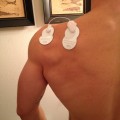Please enjoy a guest post on a topic near and dear to our heart from our friend, Dan Chabert: Writing from Copenhagen, Denmark, Dan is an entrepreneur, husband and ultramarathon distance runner. He spends most of his time on runnerclick.com, monicashealthmag.com, and gearweare.com and nicershoes.com. He has been featured on runner blogs all over the world.
Shin splints are a very common symptom amongst runners, especially beginners. This injury affects approximately 40% of beginner runners according to coach Jeff Gaudette. This injury is also known as medial tibial stress syndrome.
For a long time it was thought that shin splints were caused by small tears in the muscular tissue or inflammation of the muscles, causing intense pain. However, modern studies reveal that the shin splints are caused by flexing in the tibial bone. It’s very common for people to misdiagnose any tibial pain as shin splints– consider visiting a doctor to confirm the symptoms.
Causes & Prevention
So, what causes shin splints and how can you deal with it?
This injury is caused by loads of stress being placed on the tibial bone and muscles. Your bones are bent slightly every time you run, and your body needs an appropriate amount of rest in order to repair the tears in the muscular tissues, as well as any irregularities in the bone.
Once your muscles and bones receive the appropriate rest, they become even stronger than they were before. However, if you skip rest and continue to add stress to your shin you’re likely to suffer shin splints. Every time you work your shin and give it enough rest, it will become slightly stronger; this is why experienced runners are less likely to suffer this injury. Beginner runners on the other hand, are very susceptible to this injury.Female runners are also more likely to suffer from shin splints due to their lower bone density.
Some of the principal reasons behind shin splints are:
- Increasing your mileage and running pace too often. Progressing is important, but it’s more important to keep a reasonable amount of progress to avoid stress overload.
- Improper running form will increase the pressure placed on the shin. Striking the floor with an improper angle can instantly cause you shin splints.
- Having weak calf muscles increases your risks of having shin splints, due to the poor resistance offered by the support muscles.
The principal symptom of shin splints is acute shin pain. To prevent further injury, you should instantly stop running if you experience any shin inflammation or pain, as continuing to exercise can turn the injury into a chronic issue.
Training your calves, core and hip will considerably reduce your chances of shin splints. Keep in mind that running is not the only activity that can place stress on your shin.
Lastly, practicing your running form is a decisive factor in avoiding shin splints. Avoid extremely irregular terrains, as they can place lots of shock distributed unevenly through the shin.
Treating Shin Splints
Pain coming from the shin usually represents a call from your body asking for rest. Generally, avoiding exercise for a few days should relieve the pain. In regular cases, up to three days of rest should be enough to make the symptoms disappear.
Applying ice bags can reduce the inflamed muscles and can speed up your recovery. However, there’s no scientific back up that confirms the use of ice as a solid solution for shin splints. Additionally, placing your legs above the rest of your body will reduce the blood flow to the inflamed zone, thus reducing the inflammation.
Painkillers such as ibuprofen always come in handy when it comes to reducing the pain during your recovery. Do consult your doctor before taking any further meds, as side effects can get things pretty messy.
Depending on the severity of your injury, dynamic stretching with proper range of motion can reduce some of the tension located in the sore shin muscles. Don’t perform any kind of intense exercises; you should be aiming for slow and soft movements. If pain intensifies at any point of the stretching, you should stop immediately.
For serious cases, physical therapy is likely to be necessary. You’ll want to consult an expert for a proper diagnose and therapy plan before you continue.
People who have suffered previous shin splints are probable to have a repeated injury if they didn’t treat it correctly. To avoid any future inconvenient or injuries, make sure you thoroughly recovered before hitting the track again. Proceeding without sufficient rest or treatment can lead to extreme cases of stress fractures, even though very few cases end up in the operation room.
Recovery Methods
There’s a large list of exercises and practices that can help you recover from a shin splint injury. You can practice them from your home, maintaining a soft rhythm at all times– you don’t want the solution to become worse than the problem.
Sit on a chair and draw the alphabet in imaginary letters with the toes of your injured leg. This is a great way to start your recovery and preventing future injuries. Perform the motions for the full alphabet up to 5 times a day, depending on the severity of your injury. Don’t push it too far, take any amount of rests you need if your shin hurts.
If you feel like you can add some intensity to your shin, go ahead and walk on the tip of your toes for approximately 20 seconds. Once again, take any necessary rests and stop immediately if the pain increases. Perform this exercise up to 3 times a day, and perform 20 seconds of normal walking after each session of exercise.
When your shin feels normal and you can go back to running, wrap a compression bandage around your shin before leaving. Keep a calm pace and avoid any form of sprinting or jumping, as well as walking uphill. Riding a bicycle, swimming, or practicing yoga are excellent ways to close off your recovery.
After finalizing your recovery, you’ll want to take it easy on your running mileage. Don’t go back to the first mistake and avoid adding too many miles to your routine. Increase 10% of your mileage per week maximum.













